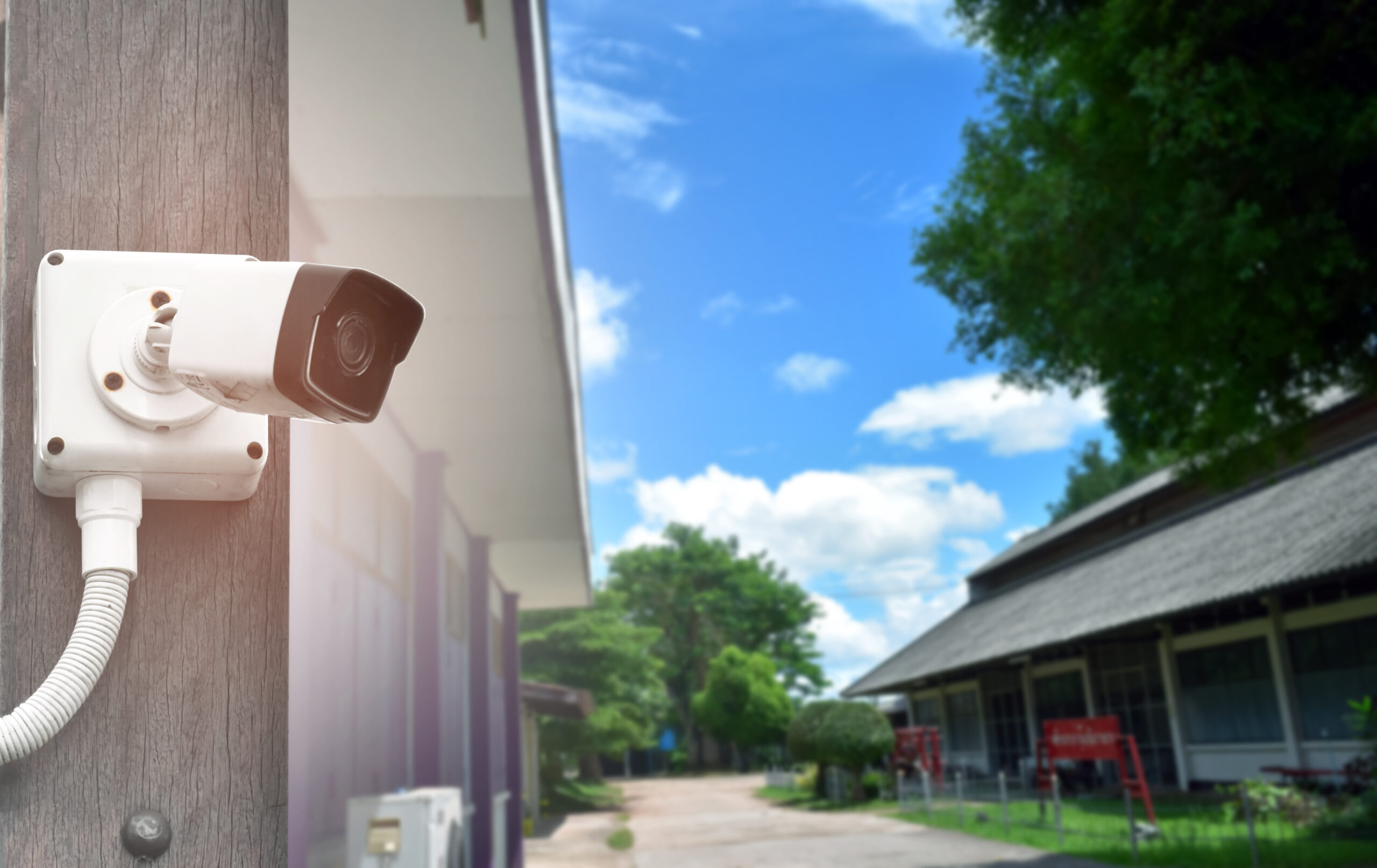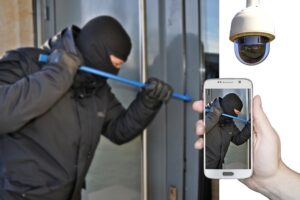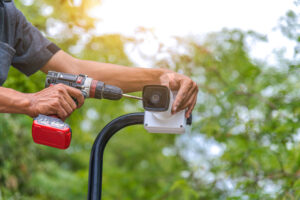In today’s ever-connected world, the concept of off-grid living is gaining traction as people seek independence from traditional infrastructure and embrace sustainable living.
However, while the allure of off-grid living is undeniable, it also presents unique challenges, particularly when it comes to ensuring home security.
In this article, we will delve into the fascinating realm of home security for the off-grid, exploring innovative solutions and strategies tailored to those who have chosen to live off the beaten path.
Home Security Tips For The Off-grid
When it comes to setting up a home security system for an off-grid property, there are several considerations to keep in mind. Here are some tips and ideas to help you secure your off-grid home:
1. Solar-powered Security Cameras
Installing solar-powered security cameras around off-grid properties is an excellent strategy for enhancing safety and monitoring activities. These cameras operate independently of the electrical grid, making them suitable for regions lacking consistent power sources. Some benefits include:
- Reduced reliance on the local power grid, resulting in lower electricity costs.
- Environmentally friendly operations due to the use of renewable energy.
- Continuous operation through solar panels, providing power even during blackouts or power outages.
- Easy installation and maintenance since most solar-powered cameras feature plug-and-play designs.
To implement this approach effectively, consider purchasing off-the-shelf solar-powered cameras or building custom systems using DIY techniques.
Popular models include the Reolink Argus 2E, VOSKER V300, and various options found on online marketplaces like Amazon. Remember to assess each camera’s features carefully, considering factors such as resolution, night vision capability, storage capacity, and integration with existing security systems
2. Motion-Activated Light
Motion-activated lights are a security feature designed for residential properties that automatically turn on when they detect movement within their range or sensing area.
They serve two primary purposes: deterring potential intruders and notifying the homeowner about external activities occurring near their residence.
When installed along the perimeter of a property, these lights create an illuminated barrier that makes it more difficult for would-be burglars to remain unnoticed while attempting to gain access to a house.
The sudden activation of bright lighting may startle intruders, causing them to flee or reconsider their actions.
Additionally, motion-activated lights provide early warning signs by alerting the homeowners to unusual movements in their surroundings. This allows residents to be aware of suspicious behavior before it escalates into a potentially dangerous situation. By providing visibility at night, these lights enhance safety both inside and outside the dwelling.
3. Wireless Alarm Systems
A wireless alarm system with solar power or a backup battery represents a modern and eco-friendly approach to securing homes against unwanted entries. Such systems offer several advantages over traditional wired alternatives due to their flexibility, ease of installation, and environmental considerations.
The key components of this type of system typically consist of:
- Wireless Sensors: These devices communicate with the central control panel via radio waves instead of physical connections like cables. Examples include motion sensors, which detect body heat and movement; door/window sensors, which monitor openings; and glass break sensors, which listen for specific frequencies emitted during window shattering.
- Central Control Panel: This device receives signals from all connected sensors and processes them accordingly. It can trigger audible alerts (such as sirens) and send notifications to smartphones or other remote monitoring devices.
- Alarms: Audible alarms can scare off intruders and notify neighbors of a possible threat. Some advanced systems allow users to customize alarm sounds based on different types of events.
- Solar Power or Backup Battery: To ensure continuous operation even if there is a power outage, wireless alarm systems often come equipped with either solar panels or backup batteries. Solar-powered systems harness clean energy from sunlight, reducing reliance on nonrenewable sources
4. Strong Perimeter Fencing
Building a robust perimeter fence serves multiple functions in enhancing the overall security of a residential property. A well-constructed fence creates a visible boundary that discourages trespassing and prevents unauthorized access. Here are some aspects related to building a strong perimeter fence:
- Physical Barrier: A sturdy fence made of materials such as wood, metal, or PVC acts as a tangible obstacle that intruders must overcome. Taller fences increase difficulty and reduce the likelihood of successful breaches.
- Visual Deterrent: An imposing fence sends a clear message that the property is protected, making it less attractive to criminals looking for easy targets.
- Added Security Measures: Thorny bushes or plants along the fence line add another layer of defense, making it uncomfortable for individuals trying to climb or cut through the fence.
- Integration with Other Security Features: A strong perimeter fence complements other security measures such as motion-activated lights, surveillance cameras, and alarm systems. Together, these features form a comprehensive security strategy.
It is essential to choose appropriate materials and designs tailored to local conditions and threats. For instance, areas prone to high winds might require stronger foundations, while regions with abundant vegetation could benefit from thorny shrubbery.
Ultimately, a strong perimeter fence contributes significantly to creating a secure living space and protecting valuable assets
5. Guard Dogs
Introducing a guard dog to an off-grid property can greatly improve its security and sense of protection. Guard dogs have been used throughout history to safeguard human settlements, and they continue to play a vital role in contemporary security strategies. When considering a guard dog for an off-grid location, keep the following points in mind:
- Deterrence: The presence of a guard dog alone can act as a powerful deterrent to potential intruders. Criminals tend to avoid properties where they believe they will encounter aggressive animals.
- Early Warning System: Well-trained guard dogs can alert their owners to the presence of strangers or unfamiliar noises, allowing prompt action to be taken.
- Protection: In case of an actual attack, guard dogs can defend their territory and their family members, increasing the chances of preventing harm.
- Companionship: Beyond their protective qualities, guard dogs make wonderful companions who enrich the lives of their owners.
However, it is crucial to select the right breed and properly train the dog to ensure effective security outcomes. Not every breed is suitable for guard duty, so research should be conducted carefully to find the best fit for each individual’s needs. Furthermore, responsible ownership requires consistent training and socialization to maintain the dog’s good temperament and effectiveness as a protector.
6. Neighborhood Watch
Establishing a neighborhood watch program among off-grid homeowners offers numerous benefits in terms of community safety and collective vigilance. By forming a network of concerned citizens, participants can work together to promote a safer living environment and foster mutual support. Key elements of a neighborhood watch program include:
- Community Engagement: Encouraging participation from fellow off-grid homeowners fosters trust and cooperation between neighbors.
- Awareness Training: Providing information on how to identify and respond to various forms of criminal activity empowers participants to take informed action.
- Reporting Suspicious Activity: Sharing observations and reporting incidents strengthens the ability to address emerging threats effectively.
- Collaborative Efforts: Working together to implement additional security measures, such as shared patrol routes or jointly funded security equipment, increases the overall level of protection.
Neighborhood watch programs do not replace law enforcement but rather supplement existing services by offering eyes and ears on the ground.
Participants learn to recognize patterns of suspicious behavior and report them to authorities, thereby contributing to a safer environment for everyone involved.
7. Emergency Communication
Ensuring reliable communication channels in emergencies becomes especially critical in off-grid locations where conventional means of communication may fail. Satellite phones and two-way radios represent viable alternatives to standard mobile networks, enabling seamless communication under challenging circumstances.
- Satellite Phones: These devices connect directly to satellites orbiting Earth, eliminating the need for terrestrial infrastructure. As long as there is an unobstructed view of the sky, satellite phones can facilitate voice calls and text messages worldwide. However, they usually require a subscription service and can be expensive compared to other options.
- Two-Way Radios: Two-way radios use shortwave frequencies to transmit data across distances greater than those covered by typical walkie-talkies. While they cannot match the capabilities of satellite phones, they still provide a cost-effective solution for communicating locally within a limited radius.
Both satellite phones and two-way radios enable quick response times in emergency situations, ensuring timely assistance from friends, family, or first responders.
Off-grid dwellers should prioritize acquiring dependable communication tools to minimize risks associated with isolation and lack of immediate contact with the rest of society
8. Secure Entry Points
To secure entry points at an off-grid residence, follow these recommendations:
Install Sturdy Locks: Use high-quality deadbolts and locksets on all external doors and windows. Opt for Grade 1 or Grade 2 locks, which are known for their strength and resistance to forced entry attempts.
- Reinforce Door Frames: Upgrade weak door frames with reinforcements made of solid wood or metal to resist kicking and prying attacks.
- Consider Reinforcement Grilles or Bars: Add extra layers of protection by installing grille or bar systems on vulnerable windows and sliding glass doors. Be aware that these may obstruct views and limit airflow, so balance security concerns with comfort and aesthetics.
- Choose Durable Materials: Select durable materials for doors and windows, such as solid wood, fiberglass, or metal cladding, to enhance their resistance to damage and wear.
- Regular Maintenance: Maintain locks and hardware regularly to ensure optimal performance and longevity. Rekey or replace locks after moving into a new property or experiencing a security breach.
Remember that these precautionary measures are essential for minimizing the risks associated with off-grid living, where traditional security systems may not function reliably.
Always consult with professionals when selecting and installing security products to maximize their effectiveness and compatibility with your off-grid setup.
9. Emergency Plan
Creating an emergency plan specific to off-grid homes helps prepare residents for responding appropriately during unexpected events such as break-ins or natural disasters. Follow these steps to develop an effective emergency plan:
- Identify Potential Risks: Assess the unique challenges posed by off-grid living, including power failures, extreme weather conditions, and limited access to emergency services.
- Create an Evacuation Route: Determine safe escape routes based on the layout of your property and surrounding terrain. Ensure that all family members understand the evacuation route and know where to meet once outside the premises.
- Designate Safe Rooms: Identify interior rooms that offer maximum protection against intruders, such as those without windows or easily accessible entrances.
- Establish Contact Protocols: Decide on a primary method of communication (e.g., satellite phone) and establish backup plans if the primary system fails. Designate one person to call emergency services and inform others about the situation.
- Practice Drills: Conduct regular drills to test the efficiency of your emergency plan. This ensures that everyone understands their roles and responsibilities during a crisis.
- Stock Essentials: Keep necessary supplies readily available, such as flashlights, nonperishable food items, water, blankets, and first aid kits.
- Keep Important Documents Handy: Store copies of important documents, such as identification cards, insurance policies, and medical records, in a fireproof container or safe deposit box.
- Inform Local Authorities: Share your emergency plan with relevant agencies, such as police departments and fire stations, to expedite response time in case of an incident.
By developing and implementing this emergency plan, off-grid families can better manage crises and mitigate risks associated with isolated living environments.
10. Regular Security Checks
Performing routine security checks at your off-grid property plays a significant role in maintaining its integrity and reducing the risk of security breaches. Here are some suggestions for conducting regular security checks:
- Visual Inspection: Walk around the perimeter of your property, checking fences, gates, and walls for signs of damage or weaknesses. Look for loose boards, broken latches, or gaps that could allow easy access to your land.
- Door and Window Checks: Test all exterior doors and windows to ensure they close and latch correctly. Pay special attention to hidden or less frequently used entries, such as basement hatches or attic stairs.
- Lighting Evaluations: Verify that outdoor lighting fixtures are functioning properly and illuminating key areas of your property. Consider adding motion sensor lights to increase visibility while conserving energy.
- Alarm Systems Tests: If you have installed alarms, conduct periodic tests to confirm proper operation. Check batteries and connections to ensure everything is in order.
- Security Camera Reviews: Review footage captured by surveillance cameras to monitor for unusual activities or potential issues. Update the camera firmware and settings periodically to optimize functionality.
- Lock Inspections: Examine locks and hardware to verify that they remain undamaged and functional. Replace worn components immediately to prevent future problems.
- Landscape Management: Trim trees and shrubs near your house to eliminate hiding spots for would-be intruders. Remove debris and clutter that might impede visibility or create obstacles.
- Document Changes: Record any changes observed during inspections, whether positive or negative. This documentation serves as a reference point for future evaluations and provides evidence of improvements over time.
Conducting regular security checks allows you to proactively address potential vulnerabilities before they become serious issues. It also demonstrates your commitment to protecting yourself and your property, potentially deterring criminals looking for soft targets
Conclution
Living off-grid presents unique challenges when it comes to securing personal safety and property.
By employing strategic approaches such as investing in reliable communication tools, fortifying entry points, creating comprehensive emergency plans, and performing regular security checks, individuals residing in off-grid environments can significantly reduce the risks associated with isolation and limited resources.
Taking these actions will not only improve overall preparedness but also foster peace of mind, knowing that appropriate measures are in place to protect oneself and loved ones.
Ultimately, staying vigilant and proactive in addressing security needs remains crucial for thriving off-grid lifestyles.




